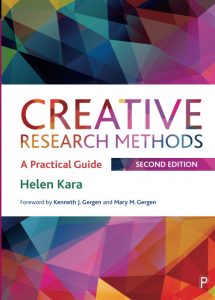Helen Kara reflects on writing the second edition of her book, Creative Research Methods: A Practical Guide, following the publication of the first edition in 2015. In this feature essay, she explores the differences between the two editions and also discusses the processes of updating the content, changing the structure and title, submitting the proposal and receiving and responding to reviewer comments.
Creative Research Methods – Writing the Second Edition
 Creative Research Methods: A Practical Guide was my second second edition. The first second edition was fairly straightforward – one new chapter, update the rest of the text and the references – which led me to believe the second would be similarly straightforward. How very wrong I was.
Creative Research Methods: A Practical Guide was my second second edition. The first second edition was fairly straightforward – one new chapter, update the rest of the text and the references – which led me to believe the second would be similarly straightforward. How very wrong I was.
The first edition of Creative Research Methods, published in 2015, conceptualised the field under four headings. These were not mutually exclusive but provided a useful way to think and talk about creative methods: arts-based research; mixed-methods research; research using technology; and transformative research frameworks. Since then, work with mobile and sensory methods in particular, and embodied research in general, had expanded dramatically, meaning I needed to add embodied research as a fifth heading for the second edition. Also in the first edition, led by the literature, I had classified decolonising methods within transformative research frameworks. After publication I met some Indigenous researchers who taught me that the Indigenous research paradigm stands alone and predates the Euro-Western research paradigm, and that decolonising methods belong within the Indigenous paradigm. So I needed to correct that error. And I wanted to include more examples of work from the Global South.
I wrote a proposal on that basis which was reviewed by four very helpful people (if you were one of them: thank you!). They were all familiar with the first edition and most were positive, though one thought it might be too soon to write a second edition. One particularly useful point was that despite the four headings, the first edition gave much less weight to research using technology than to the other three – something that had completely escaped me. So I worked hard to rebalance that in the second edition, which led to a total restructure of the second part of the book. In the first edition, Chapters Five to Eight covered data gathering, data analysis, research reporting and presenting findings, respectively. In the second edition, each of these was split into two, to form Chapters Six to Thirteen: arts-based and embodied data gathering, using technology and mixing methods in data gathering and so on. I also added a new Chapter Three on transformative research frameworks and Indigenous research.
I was fascinated by the reviewers’ views of the audience for this book, from a list of options provided by the publisher. The only thing they all agreed on was that the audience would not include policymakers. Three agreed it would include academics, postgraduates and professional students. Two also suggested undergraduates and independent researchers, and one added methods teachers and academic researchers. I hear from readers in all of these categories apart from undergraduates, but I do hear from lecturers who use the book with undergraduates. When I wrote the first edition, I thought only doctoral students, early career researchers and maybe some doctoral supervisors would be interested. I am very glad to have been so wrong about that!

After some thought and discussions with my editor at Policy Press, I revised my proposal in May 2019 to suggest fifteen chapters instead of ten, and 100,000 words instead of 80,000. If I had written that sentence at the time, it might have occurred to me that 50 per cent more chapters would be unlikely to fit into 25 per cent more words. It didn’t – which meant that by September 2019 I needed to write a desperate email to my editor, begging for more words. Fortunately she was receptive and granted me an extra 7,000.
Another thing I didn’t foresee was just how much had been written on creative research methods, in one form or another, in the five years since I had put together the first edition. I spent hundreds of pounds on books, and downloaded dozens of journal articles to add to the dozens I already had in my ‘second edition’ folder (created when the first edition was published, to store all the information people kindly emailed and tweeted to me when they knew of my interest). In the inevitable writer’s trade-off between breadth and depth, I was always going to go for breadth, so it was important to reference heavily to help readers follow up their topics of interest. But references use up so many words … I was a professional academic copy-editor in a former life, and I’m good at distilling and condensing my own prose, but I can’t do anything to reduce the wordiness of references.
The first edition was called ‘Creative Research Methods in the Social Sciences’. It should really have been ‘Creative Research Methods in the Social Sciences, Arts, and Humanities’, but that was too long. Also, even the first edition contained several examples of creative methods from science, technology, engineering and mathematics (STEM) disciplines. As I read for the second edition, I found more and more examples of creative methods from STEM disciplines, and enjoyed including them in the book. In February 2020 I was teaching creative research methods at Dublin City University to a group of doctoral students from right across the disciplines: engineering, law, business, sociology and so on. During our discussions I had a light-bulb moment and, while they were involved in doing an exercise, I fired off an email to my editor: for the second edition, could we drop the ‘in the social sciences’ part of the title? Within hours I had a positive reply.
Eventually I finished the manuscript and it was reviewed by three very helpful people (if you were one of them: thank you!). Again, they were very positive about the book, making some lovely comments: ‘It’s a model of accessible communication’ is one of my favourites. They also all read the manuscript very thoroughly and made some really useful points about structure, chapters, sections, paragraphs and even specific words. One made the point that ‘multi-modal’ is taking over from ‘mixed-methods’ for good reason, so I changed that in the text, and made a bunch of other revisions before handing the manuscript over to Policy Press with a sigh of relief.
The second edition does include more examples from the Global South, but not as many more as I would have liked. As I was reading for the second edition, I learned that in some countries in the Global South creative research methods are not yet acceptable in academia. I wrote about this in the introductory chapter, asking readers to pass on any good examples of creative research methods from countries or regions that are under-represented in my book. I haven’t received any yet, but I have more examples, and more contacts, through the more recent work I have done with Su-ming Khoo on researching in the age of COVID-19. So I will definitely be able to improve this further in the third edition.
So I have written two second editions now, and they were very different experiences. The first was quite straightforward, the second was much more difficult than I anticipated. This makes it tricky to come up with a neat set of tips for others who may be planning their first second edition. The publisher’s proposal form will provide some guidance. I should say, though, that it’s definitely worth doing, because even when it’s complicated, producing a second edition is a lot less work than writing a whole new book!
Note: This feature essay gives the views of the author, and not the position of the LSE Review of Books blog, or of the London School of Economics.
Image Credit: Photo by Dstudio Bcn on Unsplash.







